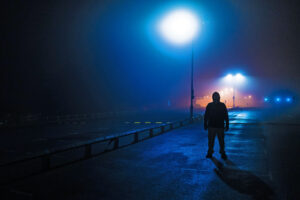Lockdown reportedly returned to Bexleyheath on Saturday. As rumours about an impending wave of “TikTok-fuelled looting” circulated on social media, shopkeepers debated whether it was safe to unlock their doors. Eventually they did, but only after a dispersal order was issued, handing the police additional powers to snuff out antisocial behaviour. No doubt the Met’s officers hoped to avoid a repeat of the carnage that had unfolded earlier in the week, when gangs of children ran amok on Oxford Street, allegedly in the hope of ransacking a JD Sports.
Central London isn’t “safe anymore”, led one report after the mayhem. Countless others carried a similar message: that lawlessness had returned to the capital’s streets.
You will forgive me if I reserve my shock and outrage. I was born in Hackney, east London, in the early Seventies, when such scenes regularly played out in working-class communities to little or no media fanfare. My inner-city state schools were more like prisons, and by the time I was 18, I had seen more acts of violence than I care to remember. I have been stabbed, witnessed numerous muggings, and seen first-hand the effects of extreme violence, usually meted out on the most vulnerable. I often think back to my grandmother’s elderly neighbours on both sides. Both were widows; both had husbands who were decorated war heroes; both were brutally mugged as they collected their pensions from the local post office.
During the Eighties, shootings became more common, adding to the chaos which had already escalated after the mental health wards of Hackney Hospital threw their confused patients onto the streets as part of a “care in the community” scheme. I left the area in my mid-twenties and lived and worked in early post-war Bosnia. It was still violent, with guns widespread. But the irony was that I felt safer there than in Hackney; the former paramilitaries that ran the local bars at least had a social code.
Despite the horrors, my memories of Hackney remain mixed. As violent and poor as it once was, there was always a sense of solidarity. The settled white working-class communities were nearly always at the sharp end of the policies imposed by successive post-war governments, almost all without democratic consent. Mass immigration radically altered those communities, but they largely muddled along as best they could, forming cross-cultural social norms. At my grandmother’s funeral, mourners from every race gathered to commemorate the life of a white working-class cockney matriarch. Born into desperate poverty to a widowed mum with seven kids in the Thirties, she formed deep bonds with the first-generation Afro-Caribbean mums who, as they grew older, would look out for each other.
Over the past decade, however, such multiracial harmony has slowly been replaced with new cultural norms centred around self-expression and hyper-individualism. The civilising nature of national identity and shared values — precisely those that held together the long put-upon British working class, black and white — are now viewed as gauche and unreconstructed concepts. In their place, today’s cultural narratives divide society along identity lines. If it erases the agency and “lived experience” of long-established working-class communities and casts the UK as a racist hellhole, so be it.
And so, our media and political classes shifted their focus, falling back on racial battlelines that had already inflamed the US but bore little relation to the reality of day-to-day life in Britain. Last August, the researcher David Rozado revealed how extensive this shift has been. He found that, between 2010 and 2020, “terms such as racism and white supremacy in popular UK media outlets increased on average by 769% and 2,827%, respectively”. During the same period, “mentions in BBC content of terms suggestive of racism have increased by over 802%… hate speech (880%), … or slavery (413%)”.
What impact is this likely to have in Hackney, which remains one of London’s most dangerous boroughs? My time there and in Bosnia taught me that while human beings naturally tend towards tribalism, the steady cultivation of tolerance and mutual respect can be learnt and transmitted anew to each generation through our institutions and broader culture. But in London, these principles have since been erased, replaced with a moral evaluation of human nature that is determined on ahistorical levels of oppression. As egalitarianism fell out of favour, the bonds which held a community together, encouraging certain behaviours and outlawing others, started to fray.
Perhaps with this in mind, we can interpret the entrenchment of crime and anomie in London as the beginning of the end for our political and cultural elites’ long-held luxury beliefs. It is all too easy to destroy the organic evolution of human neighbourhoods; a fragile, chaotic and precious process that must be nurtured from generation to generation. From its ruins, we do not get a top-down corporate utopia of “diverse and inclusive” communities. Instead, we get a society in which the fragile ties of human solidarity are rendered ever more vulnerable, the strong prey on the weak, and raw power reins.
Disclaimer
Some of the posts we share are controversial and we do not necessarily agree with them in the whole extend. Sometimes we agree with the content or part of it but we do not agree with the narration or language. Nevertheless we find them somehow interesting, valuable and/or informative or we share them, because we strongly believe in freedom of speech, free press and journalism. We strongly encourage you to have a critical approach to all the content, do your own research and analysis to build your own opinion.
We would be glad to have your feedback.
Source: UnHerd Read the original article here: https://unherd.com/


